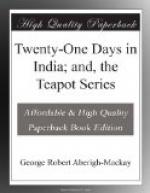You will have learnt from Mr. Caird that indigo grows in cakes (the ale is imported); to his description of the process of manufacture I can only add that the juice is generally expressed in the vernacular. You give a cake of the raw material to a coloured servant, you stand over him to see that he doesn’t eat it, and your assistant canes him slowly as he squeezes the juice into a blue bottle. Blue pills are made of the refuse; your female servants use aniline dyes; and there you are. If any one dies in any other way you can refuse him the rites of cremation; fine him four annas; and warn him not to do it again. This is a burning question in Tirhoot and occasions much litigation.
Jamie Macdonald has now a contract for dyeing the Blue ribbons of the Turf; Tommy Begg has taken the blue boars and the Oxford Blues; and Bobby Thomas does the blue-books and the True Blues. It may not be generally known that the aristocracy do not employ aniline dyes for their blue blood. The minor Planters do business chiefly in blue stockings, blue bonnets, blue bottles, blue beards, and blue coats. For more information of this kind I can only refer you to Mr. Caird and the Nineteenth Century.
Some Planters grow tea, coffee, lac, mother-of-pearl, pickles, poppadums and curry powder—but now I am becoming encyclopaedic and scientific, and trespassing on ground already taken up by the Famine Commission.
Fewer Planters are killed now by wild camels who roam over the mango fields, but a good deal of damage is still done to the prickly pear-trees. Mr. Cunningham has written an interesting note on this. Rewards have still to be offered for dead tigers and persons who have died of starvation. “When the Government will not give a doit to relieve a lame beggar, they will lay out ten to see a dead Indian.”— ALI BABA, K.C.B.
No. XIII
THE EURASIAN
A STUDY IN CHIARO-OSCURO
[Illustration: THE EURASIAN—“A study in chiaro oscuro.”]
[November 1, 1879.]
The Anglo-Indian has a very fine eye for colour. He will mark down “one anna in the rupee” with unerring certainty; he will suspect smaller coin. He will tell you how he can detect an adulterated European by his knuckles, his nails, his eyebrows, his pronunciation of the vowels, and his conception of propriety in dress, manner, and conduct.
To the thorough-bred Anglo-Indian, whose blood has distilled through Haileybury for three generations, and whose cousins to the fourth degree are Collectors and Indian Army Colonels, the Eurasian, however fair he may be, is a bete noir. Mrs. Ellenborough Higgins is always setting or pointing at black blood.
And sometimes the whitey-brown man is objectionable. He is vain, apt to take offence, sly, indolent, sensuous, and, like Reuben, “unstable as water.” He has a facile smile, a clammy hand, a manner either forward or obsequious, a mincing gait, and not always the snowiest linen. [In very dangerous cases he has a peculiar smell.]




